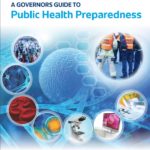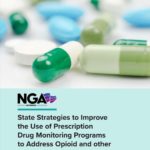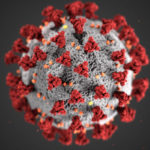Substance Use Disorder And Addiction
Governors have long been at the forefront of efforts to prevent and treat opioid use disorder and substance use disorder, working with stakeholders to mount a comprehensive response to the opioid epidemic.
Since 2012, the National Governors Association Center for Best Practices has supported states in their efforts to help prevent and treat substance use disorder. Over the years, NGA Health and NGA Public Safety and Legal Counsel have jointly worked with states to identify and implement evidenced based best practices related to substance use disorder. NGA focus areas include but are not limited to:
- Sharing evidenced based prevention, treatment, and recovery strategies and programs;
- Using data and evaluation in policy development;
- Improving outcomes for targeted populations (justice-involved individuals, pregnant and parenting women, LGBTQIA+, people of color, and other historically underrepresented populations);
- Expanding access to medication for opioid use disorder (MOUD);
- Identifying trends in polysubstance use and identifying comprehensive responses to addiction;
- Addressing infectious diseases as a result of SUD/OUD;
- Strategies to improve the treatment of individuals with co-occurring disorders; and
- Increasing access to non-opioid management of chronic pain.
Meet Our Team
- Marianne Gibson, Program Director, Substance Use and Mental Health
- Lauren Dedon, Senior Legal Policy Advisor
- Maria Kearl, Policy Analyst, Public Safety and Legal Counsels
Projects
No posts found.
Publications

The Governor’s Guide to Public Health Preparedness
(View/Download) Executive Summary Beginning on their first day in office, governors must prepare for emergencies of all types and, along with providing for the public’s safety, governors must also think ...
NGA Health to Assist 5 States on Addressing Infectious Diseases Related to Substance Use
The National Governors Association Health Division (NGA Health) will be working with five states -- Alaska, Idaho, Iowa, Nevada and Tennessee -- on a learning lab highlighting best practices around ...
Addressing the Infectious Disease Consequences of the Opioid Epidemic
Governors are at the forefront of efforts to curb the opioid epidemic and related challenges, including increased transmission of human immunodeficiency virus (HIV), hepatitis C virus (HCV) and other blood-borne ...
Leveraging Data to Unleash Innovation & Curb the Opioid Epidemic
In the complex fight against the opioid overdose epidemic, states can use data to identify critical needs, direct resources and drive policymaking. An NGA survey of 41 states conducted in ...
Opioid Reference Guide for New Administrations
Developed by the NGA Center through a survey and extensive consultation with senior state officials and other national experts, our new opioid "Reference Guide for New Administrations" highlights key questions, ...
Emerging Trends in the Evolving Opioid Epidemic
While the opioid overdose epidemic justifiably dominates national and state-level headlines, a significant issue is re-emerging for governors and policymakers across the country: cocaine, methamphetamine (meth) and stimulants are inflicting ...
Substance Use Disorder And Addiction Library

State Strategies to Improve the Use of Prescription Drug Monitoring Programs to Address Opioid and other Substance Use Disorders
(View/Download) Executive Summary States have implemented many different strategies to address opioid use disorder/substance use disorders (OUD/SUD) and promote safe prescribing practices. One of these strategies is maintaining prescription drug ...

State Strategies to Support Access to Substance Use Disorder Treatment Services through the COVID-19 Pandemic
(View/Download) New Challenges Prior to the COVID-19 pandemic, many governors were looking for ways to strengthen substance use disorder (SUD) provider capacity as part of their comprehensive response to the ...

The Governor’s Guide to Public Health Preparedness
(View/Download) Executive Summary Beginning on their first day in office, governors must prepare for emergencies of all types and, along with providing for the public’s safety, governors must also think ...
NGA Health to Assist 5 States on Addressing Infectious Diseases Related to Substance Use
The National Governors Association Health Division (NGA Health) will be working with five states -- Alaska, Idaho, Iowa, Nevada and Tennessee -- on a learning lab highlighting best practices around ...
State Leaders Convene for Strategies on Drug Treatment and Recovery for Justice-Involved Populations
National Governors Association Workshops in Ohio and Louisiana Spotlight Medication Assisted Treatment in Criminal Justice System The National Governors Association (NGA) brought together nine states in Cleveland, Ohio, and New ...
Regional Workshops on Expanding Access to Medication Assisted Treatment for Justice-Involved Populations
June 10-11 and 13-14, 2019 | Cleveland, Ohio and New Orleans, Louisiana NGA Solutions: The Center for Best Practices hosted two regional workshops on expanding access to medication assisted treatment ...
States Pursue Strategies to Address Infectious Disease Related to the Opioid Epidemic
Priorities Include Expanding Access to Syringe Services Programs and Using Data to Target High-Risk Communities With viral infections attributable to injection drug use on the rise, the National Governors Association ...
Addressing the Infectious Disease Consequences of the Opioid Epidemic
Governors are at the forefront of efforts to curb the opioid epidemic and related challenges, including increased transmission of human immunodeficiency virus (HIV), hepatitis C virus (HCV) and other blood-borne ...
Institute for State Criminal Justice and Public Safety Executives
Seattle | May 21-22, 2019 NGA hosted 34 states in Seattle to discuss issues around criminal justice and public safety at the 2019 Institute for State Public Safety Executives. Held ...
Resources
- Vital Signs on overdose disparities by race, ethnicity, and other important social determinants.
- DOSE Dashboard includes monthly and annual nonfatal overdose data from syndromic surveillance systems in 42 states, including the District of Columbia. This represents the most up to date data that CDC’s DOSE system has available and is updated shortly after new data are made available each month. The dashboard provides data visualization that responsively adjusts to your selection of drug, state, month/year, age, and sex.
- SUDORS Dashboard includes comprehensive drug overdose data from 2020, from funded jurisdictions that met inclusion criteria. Participating jurisdictions provided data from death certificates and medical examiner/coroner reports (including scene findings, autopsy reports, and full postmortem toxicology findings). The dashboard provides a downloadable dataset that includes annual counts, percentages, and rates of drug overdose deaths per 100,000 persons.
- Overdose Funding Snapshots are a useful repository for federal and state funding data. These pages contain a history of CDC’s overdose funding, major milestones, and an interactive map with clickable states featuring individual state investments and key examples of work therein.
- Patient- and County-level Trends in Nonfatal Opioid-involved Overdose Emergency Medical Services Encounters, 491 Counties in 21 States, January 2018–March 2022: This report leverages very timely data on non-fatal opioid-involved EMS encounters using the Biospatial data. In 491 counties across 21 states, the rate of EMS encounters for nonfatal opioid-involved overdoses increased, on average, 4% quarterly during January 2018–March 2022. EMS encounter data involving suspected nonfatal opioid-involved overdose complements ED data and allows for near real-time analysis, which can inform public health response and prevention efforts.
- CDC Feature: International Overdose Awareness Day: A Time to Remember and Take Action, CDC’s IOAD feature, presents vital overdose statistics, offers tips on recognizing signs of overdose, and provides informational resources.
- A qualitative assessment of circumstances surrounding drug overdose deaths during the early stages of the COVID-19 pandemic, SUDORS Data Brief: The latest SUDORS data brief presents a qualitative assessment of circumstances surrounding drug overdose deaths during early stages of the COVID-19 pandemic, most notably physical and mental impacts of the pandemic and missed touchpoints or opportunities for intervention. It is critical to expand SUD screening, link persons into care and treatment, retain persons in SUD treatment, and expand telehealth during emergencies to identify and provide services to persons at increased risk of overdose.

